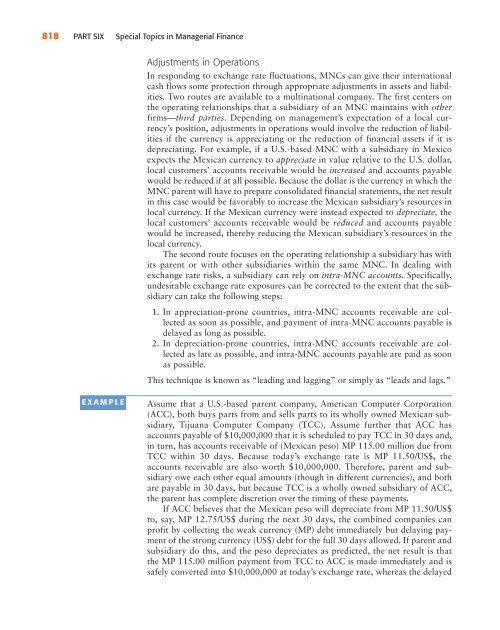Chapter 18 International Managerial Finance
Chapter 18 International Managerial Finance
Chapter 18 International Managerial Finance
You also want an ePaper? Increase the reach of your titles
YUMPU automatically turns print PDFs into web optimized ePapers that Google loves.
8<strong>18</strong> PART SIX Special Topics in <strong>Managerial</strong> <strong>Finance</strong><br />
EXAMPLE<br />
Adjustments in Operations<br />
In responding to exchange rate fluctuations, MNCs can give their international<br />
cash flows some protection through appropriate adjustments in assets and liabilities.<br />
Two routes are available to a multinational company. The first centers on<br />
the operating relationships that a subsidiary of an MNC maintains with other<br />
firms—third parties. Depending on management’s expectation of a local currency’s<br />
position, adjustments in operations would involve the reduction of liabilities<br />
if the currency is appreciating or the reduction of financial assets if it is<br />
depreciating. For example, if a U.S.-based MNC with a subsidiary in Mexico<br />
expects the Mexican currency to appreciate in value relative to the U.S. dollar,<br />
local customers’ accounts receivable would be increased and accounts payable<br />
would be reduced if at all possible. Because the dollar is the currency in which the<br />
MNC parent will have to prepare consolidated financial statements, the net result<br />
in this case would be favorably to increase the Mexican subsidiary’s resources in<br />
local currency. If the Mexican currency were instead expected to depreciate, the<br />
local customers’ accounts receivable would be reduced and accounts payable<br />
would be increased, thereby reducing the Mexican subsidiary’s resources in the<br />
local currency.<br />
The second route focuses on the operating relationship a subsidiary has with<br />
its parent or with other subsidiaries within the same MNC. In dealing with<br />
exchange rate risks, a subsidiary can rely on intra-MNC accounts. Specifically,<br />
undesirable exchange rate exposures can be corrected to the extent that the subsidiary<br />
can take the following steps:<br />
1. In appreciation-prone countries, intra-MNC accounts receivable are collected<br />
as soon as possible, and payment of intra-MNC accounts payable is<br />
delayed as long as possible.<br />
2. In depreciation-prone countries, intra-MNC accounts receivable are collected<br />
as late as possible, and intra-MNC accounts payable are paid as soon<br />
as possible.<br />
This technique is known as “leading and lagging” or simply as “leads and lags.”<br />
Assume that a U.S.-based parent company, American Computer Corporation<br />
(ACC), both buys parts from and sells parts to its wholly owned Mexican subsidiary,<br />
Tijuana Computer Company (TCC). Assume further that ACC has<br />
accounts payable of $10,000,000 that it is scheduled to pay TCC in 30 days and,<br />
in turn, has accounts receivable of (Mexican peso) MP 115.00 million due from<br />
TCC within 30 days. Because today’s exchange rate is MP 11.50/US$, the<br />
accounts receivable are also worth $10,000,000. Therefore, parent and subsidiary<br />
owe each other equal amounts (though in different currencies), and both<br />
are payable in 30 days, but because TCC is a wholly owned subsidiary of ACC,<br />
the parent has complete discretion over the timing of these payments.<br />
If ACC believes that the Mexican peso will depreciate from MP 11.50/US$<br />
to, say, MP 12.75/US$ during the next 30 days, the combined companies can<br />
profit by collecting the weak currency (MP) debt immediately but delaying payment<br />
of the strong currency (US$) debt for the full 30 days allowed. If parent and<br />
subsidiary do this, and the peso depreciates as predicted, the net result is that<br />
the MP 115.00 million payment from TCC to ACC is made immediately and is<br />
safely converted into $10,000,000 at today’s exchange rate, whereas the delayed
















